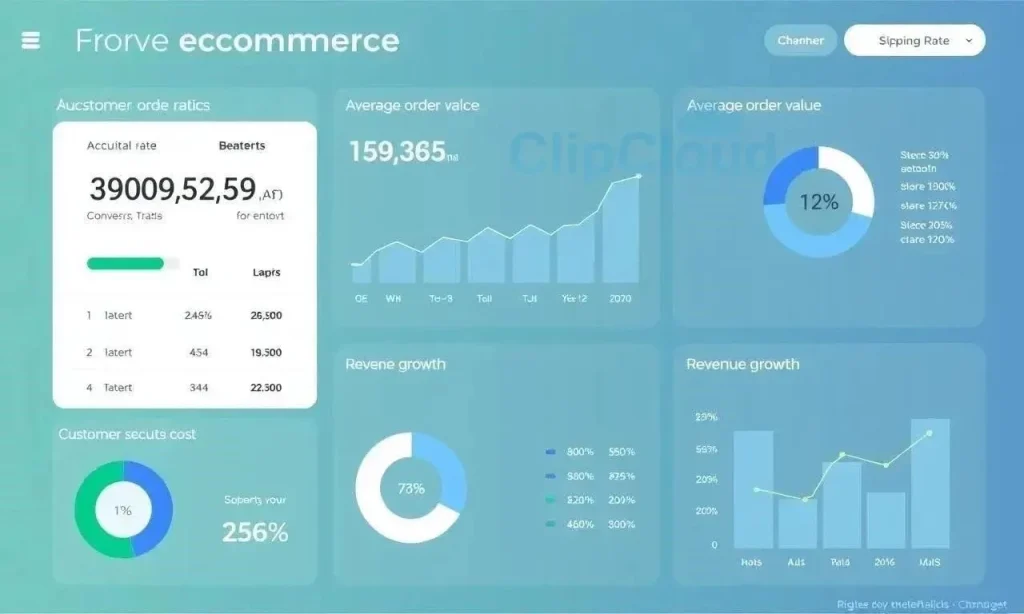Essential eCommerce Metrics to Track for Business Growth
Unlock your online store’s potential! Discover the eCommerce metrics that reveal customer secrets, skyrocket marketing, and boost your bottom line. Start tracking today!

In the dynamic world of eCommerce, success hinges on understanding and optimizing your business performance. Tracking the right eCommerce metrics provides invaluable insights into customer behavior, marketing effectiveness, and overall profitability. By meticulously monitoring these key performance indicators (KPIs), you can identify areas for improvement, make data-driven decisions, and ultimately drive sustainable growth for your online store. This article will guide you through the essential metrics that every eCommerce business should be tracking to maximize their potential.
Understanding Key eCommerce Metrics: A Deep Dive
Effective eCommerce management requires a keen understanding of various metrics that reflect different aspects of your online business. These metrics act as barometers, indicating the health and performance of your store. Let’s explore some of the most vital ones:
- Conversion Rate: The percentage of website visitors who complete a purchase.
- Average Order Value (AOV): The average amount spent per order.
- Customer Acquisition Cost (CAC): The cost of acquiring a new customer.
- Customer Lifetime Value (CLTV): The predicted revenue a customer will generate throughout their relationship with your business.
- Bounce Rate: The percentage of visitors who leave your website after viewing only one page.
- Cart Abandonment Rate: The percentage of shoppers who add items to their cart but don’t complete the checkout process.
Boosting Sales: Optimizing Conversion Rate Metrics
Conversion rate is arguably one of the most important metrics for any eCommerce business. A higher conversion rate means more visitors are turning into paying customers. Improving your conversion rate can significantly impact your revenue without necessarily increasing your website traffic.
Strategies to Improve Conversion Rate
- Optimize Website Design: Ensure a user-friendly and visually appealing website with clear calls to action.
- Improve Product Pages: Provide detailed product descriptions, high-quality images, and customer reviews.
- Streamline Checkout Process: Make the checkout process as simple and intuitive as possible, minimizing friction points.
- Offer Multiple Payment Options: Cater to different customer preferences by offering a variety of payment methods.
- Build Trust and Credibility: Display security badges, guarantees, and customer testimonials to build trust.
Driving Revenue: Analyzing Average Order Value (AOV) Metrics
Average Order Value (AOV) reflects the average amount of money customers spend on each purchase. Increasing your AOV can lead to significant revenue growth without necessarily increasing the number of transactions.
Tactics to Increase Average Order Value
- Offer Upselling and Cross-selling Opportunities: Suggest related or complementary products to customers during the checkout process.
- Implement Minimum Order Value for Free Shipping: Encourage customers to add more items to their cart to qualify for free shipping.
- Create Product Bundles: Offer discounted bundles of related products to incentivize larger purchases.
- Implement Loyalty Programs: Reward loyal customers with exclusive discounts and benefits to encourage repeat purchases and larger orders.
Managing Costs: Monitoring Customer Acquisition Cost (CAC) Metrics
Customer Acquisition Cost (CAC) measures the cost of acquiring a new customer. It’s essential to track CAC to ensure that your marketing efforts are profitable and that you’re not overspending on acquiring customers.
Calculating and Reducing Customer Acquisition Cost
To calculate your CAC, divide your total marketing expenses by the number of new customers acquired during a specific period. Reducing your CAC involves optimizing your marketing campaigns, improving your website conversion rate, and focusing on customer retention.
Building Loyalty: Understanding Customer Lifetime Value (CLTV) Metrics
Customer Lifetime Value (CLTV) predicts the total revenue a customer will generate throughout their relationship with your business. A higher CLTV indicates that customers are loyal and continue to purchase from your store over time.
Strategies to Improve Customer Lifetime Value
- Provide Excellent Customer Service: Ensure that customers have a positive experience with your brand, from the initial purchase to ongoing support.
- Personalize the Customer Experience: Tailor your marketing messages and product recommendations to individual customer preferences.
- Build a Strong Brand Community: Engage with customers on social media and create a sense of community around your brand.
- Implement a Loyalty Program: Reward loyal customers with exclusive discounts and benefits to encourage repeat purchases.
Factoid: Acquiring a new customer can cost five times more than retaining an existing one. Focusing on customer retention can significantly improve your CLTV.
Website Performance: Analyzing Bounce Rate Metrics
Bounce rate is the percentage of visitors who leave your website after viewing only one page. A high bounce rate can indicate that your website is not engaging or relevant to visitors.
Factors Contributing to High Bounce Rate
- Poor Website Design: A confusing or unattractive website design can deter visitors from exploring further.
- Slow Loading Speed: Slow loading times can frustrate visitors and cause them to leave.
- Irrelevant Content: If your website content is not relevant to the search query or advertisement that brought visitors to your site, they are likely to bounce.
- Mobile Incompatibility: A website that is not optimized for mobile devices can lead to a poor user experience and a high bounce rate.
Recovering Lost Sales: Addressing Cart Abandonment Rate Metrics
Cart abandonment rate is the percentage of shoppers who add items to their cart but don’t complete the checkout process. Recovering abandoned carts can significantly boost your sales.
Strategies to Reduce Cart Abandonment
- Simplify the Checkout Process: Make the checkout process as easy and intuitive as possible.
- Offer Guest Checkout: Allow customers to check out without creating an account.
- Provide Clear and Transparent Pricing: Show all costs, including shipping and taxes, upfront.
- Send Abandoned Cart Emails: Remind customers about the items they left in their cart and offer incentives to complete the purchase.
FAQ: eCommerce Metrics & Tracking
What are the most important eCommerce metrics to track?
Conversion Rate, Average Order Value (AOV), Customer Acquisition Cost (CAC), Customer Lifetime Value (CLTV), Bounce Rate, and Cart Abandonment Rate are crucial for understanding and optimizing your eCommerce business.
How often should I track my eCommerce metrics?
Regularly! Daily or weekly monitoring provides the most actionable insights. Monthly reporting is also essential for long-term trend analysis.
What tools can I use to track eCommerce metrics?
Google Analytics is a powerful and free tool for tracking website traffic, user behavior, and conversion rates. Many eCommerce platforms also offer built-in analytics dashboards.
How can I use eCommerce metrics to improve my business?
By identifying areas where your business is underperforming, you can implement strategies to improve your website, marketing efforts, and customer experience, ultimately driving sales and revenue.
Why is understanding Customer Lifetime Value (CLTV) important?
CLTV helps you understand the long-term value of your customers, allowing you to prioritize customer retention strategies and make informed decisions about marketing investments.
Improving Email Marketing: Focusing on Click-Through Rate (CTR) Metrics
Click-Through Rate (CTR) measures the percentage of recipients who click on a link within your email campaigns. A higher CTR indicates that your email content is engaging and relevant to your audience.
Optimizing Your Emails for a Higher CTR
- Craft Compelling Subject Lines: Your subject line is the first thing recipients see, so make it attention-grabbing and relevant to the email content.
- Personalize Your Email Content: Use recipient names and tailor the content to their interests and past purchases.
- Include Clear Call-to-Actions: Tell recipients exactly what you want them to do, such as “Shop Now,” “Learn More,” or “Download Your Free Guide.”
- Optimize for Mobile Devices: Ensure that your emails are mobile-friendly, as many people read their emails on smartphones and tablets.
Enhancing Product Discoverability: Monitoring Internal Site Search Metrics
Internal site search metrics track how users search for products within your website. Analyzing these metrics can reveal valuable insights into customer needs and product preferences.
Leveraging Site Search Data for Product Optimization
- Identify Popular Search Terms: Determine which products are most frequently searched for and ensure they are prominently displayed on your website.
- Uncover Missing Products: If users are searching for products you don’t currently offer, consider adding them to your inventory.
- Improve Product Descriptions: Ensure that your product descriptions accurately reflect the terms users are searching for.
- Optimize Search Results: Make sure that search results are relevant and easy to navigate.
Social Media Engagement: Tracking Key Performance Indicators (KPIs)
Social media KPIs measure the effectiveness of your social media marketing efforts. These metrics include likes, shares, comments, and reach.
Using Social Media KPIs to Drive eCommerce Success
- Track Engagement Rate: Monitor likes, shares, and comments to gauge how engaging your content is.
- Analyze Reach and Impressions: Understand how many people are seeing your content.
- Monitor Website Traffic from Social Media: Track how many visitors are coming to your website from your social media channels.
- Use Social Listening: Monitor mentions of your brand and products on social media to understand customer sentiment and identify opportunities for improvement.
The Importance of A/B Testing: Continuously Optimizing Your Metrics
A/B testing, also known as split testing, involves comparing two versions of a webpage, email, or advertisement to see which one performs better. Regularly A/B testing your eCommerce elements allows you to continuously optimize your metrics and improve your overall performance.
What to A/B Test for eCommerce Success
- Product Page Design: Test different layouts, images, and calls to action on your product pages.
- Checkout Process: Experiment with different checkout flows to reduce cart abandonment.
- Email Subject Lines: Test different subject lines to improve your email open rates.
- Landing Pages: Test different headlines, copy, and images on your landing pages to improve conversion rates.
Staying Data-Driven: A Continuous Process of Analysis and Improvement
Tracking eCommerce metrics is not a one-time task; it’s an ongoing process. Continuously monitor your metrics, analyze the data, and implement changes to improve your website, marketing efforts, and customer experience. By staying data-driven, you can make informed decisions and drive sustainable growth for your eCommerce business.
In the dynamic world of eCommerce, success hinges on more than just having a great product. Understanding and tracking the right metrics is crucial for making informed decisions, optimizing your strategies, and ultimately, driving growth. Without a clear understanding of your key performance indicators (KPIs), you’re essentially flying blind. This article will guide you through the essential eCommerce metrics you should be tracking, explaining why they matter and how to use them to improve your business. Analyzing these metrics helps you understand the customer journey and make smarter decisions.
Revenue Generation: Focusing on Conversion Rate Optimization
Conversion rate is arguably the most important metric for any eCommerce business. It measures the percentage of website visitors who complete a desired action, typically making a purchase. A higher conversion rate indicates that your website is effectively turning visitors into customers.
Strategies to Boost Your Conversion Rate
- Improve Website Design: Ensure your website is user-friendly, visually appealing, and easy to navigate.
- Optimize Product Pages: Use high-quality images, detailed descriptions, and customer reviews to build trust and encourage purchases.
- Offer a Seamless Checkout Process: Simplify the checkout process and reduce friction by offering multiple payment options and clear shipping information.
- Provide Excellent Customer Service: Respond promptly to customer inquiries and offer helpful support to address any concerns.
Maximizing Profitability: Understanding Average Order Value (AOV)
Average Order Value (AOV) measures the average amount spent each time a customer places an order on your website. Increasing your AOV can significantly boost your revenue without necessarily increasing your customer base.
Techniques for Increasing Your Average Order Value
- Offer Upselling and Cross-selling Opportunities: Suggest related products or upgraded versions of the items customers are already purchasing.
- Implement Order Minimums for Free Shipping: Encourage customers to add more items to their cart to qualify for free shipping.
- Create Product Bundles: Offer discounted prices on bundles of related products.
- Run Promotions and Discounts: Offer limited-time discounts or promotions to incentivize customers to spend more.
Acquiring Customers Efficiently: Monitoring Customer Acquisition Cost (CAC)
Customer Acquisition Cost (CAC) measures the total cost of acquiring a new customer. Understanding your CAC is essential for determining the effectiveness of your marketing efforts and optimizing your spending.
Strategies to Reduce Your Customer Acquisition Cost
- Optimize Your Marketing Campaigns: Refine your targeting and messaging to reach the most relevant audience.
- Improve Your Website Conversion Rate: Convert more of your existing traffic into customers.
- Focus on Organic Traffic: Invest in SEO and content marketing to attract more free traffic to your website.
- Leverage Referral Marketing: Encourage existing customers to refer new customers to your business.
Retaining Valuable Customers: Calculating Customer Lifetime Value (CLTV)
Customer Lifetime Value (CLTV) predicts the total revenue a customer will generate throughout their relationship with your business. Focusing on CLTV helps you prioritize customer retention efforts and build long-term loyalty.
Strategies to Increase Your Customer Lifetime Value
- Provide Exceptional Customer Service: Go above and beyond to meet customer needs and exceed expectations.
- Build a Strong Brand Loyalty Program: Reward loyal customers with exclusive discounts, early access to new products, and personalized offers.
- Personalize the Customer Experience: Tailor your marketing messages and product recommendations to individual customer preferences.
- Continuously Improve Your Products and Services: Regularly update your offerings based on customer feedback and market trends.
Factoid: Acquiring a new customer is significantly more expensive than retaining an existing one. Focusing on customer retention can significantly improve your profitability.
Analyzing Website Performance: Understanding Bounce Rate Metrics
Bounce rate measures the percentage of visitors who leave your website after viewing only one page. A high bounce rate can indicate problems with your website’s design, content, or user experience.
Strategies to Reduce Your Bounce Rate
- Improve Website Loading Speed: Ensure your website loads quickly to prevent visitors from leaving before they even see your content.
- Create Engaging Content: Provide valuable and relevant content that keeps visitors interested and encourages them to explore your website further.
- Optimize Website Navigation: Make it easy for visitors to find what they’re looking for.
- Ensure Mobile-Friendliness: Make sure your website is responsive and optimized for mobile devices.
Addressing Lost Sales: Analyzing Cart Abandonment Rate
Cart abandonment rate measures the percentage of shoppers who add items to their cart but fail to complete the purchase. Recovering abandoned carts can significantly boost your sales.
- Simplify the Checkout Process: Make the checkout process as easy and intuitive as possible.
- Offer Guest Checkout: Allow customers to check out without creating an account.
- Provide Clear and Transparent Pricing: Show all costs, including shipping and taxes, upfront.
- Send Abandoned Cart Emails: Remind customers about the items they left in their cart and offer incentives to complete the purchase.
Conversion Rate, Average Order Value (AOV), Customer Acquisition Cost (CAC), Customer Lifetime Value (CLTV), Bounce Rate, and Cart Abandonment Rate are crucial for understanding and optimizing your eCommerce business.
Regularly! Daily or weekly monitoring provides the most actionable insights. Monthly reporting is also essential for long-term trend analysis.
Google Analytics is a powerful and free tool for tracking website traffic, user behavior, and conversion rates. Many eCommerce platforms also offer built-in analytics dashboards.
By identifying areas where your business is underperforming, you can implement strategies to improve your website, marketing efforts, and customer experience, ultimately driving sales and revenue.
CLTV helps you understand the long-term value of your customers, allowing you to prioritize customer retention strategies and make informed decisions about marketing investments.
Click-Through Rate (CTR) measures the percentage of recipients who click on a link within your email campaigns. A higher CTR indicates that your email content is engaging and relevant to your audience.
- Craft Compelling Subject Lines: Your subject line is the first thing recipients see, so make it attention-grabbing and relevant to the email content.
- Personalize Your Email Content: Use recipient names and tailor the content to their interests and past purchases.
- Include Clear Call-to-Actions: Tell recipients exactly what you want them to do, such as “Shop Now,” “Learn More,” or “Download Your Free Guide.”
- Optimize for Mobile Devices: Ensure that your emails are mobile-friendly, as many people read their emails on smartphones and tablets.
Internal site search metrics track how users search for products within your website. Analyzing these metrics can reveal valuable insights into customer needs and product preferences.
- Identify Popular Search Terms: Determine which products are most frequently searched for and ensure they are prominently displayed on your website.
- Uncover Missing Products: If users are searching for products you don’t currently offer, consider adding them to your inventory.
- Improve Product Descriptions: Ensure that your product descriptions accurately reflect the terms users are searching for.
- Optimize Search Results: Make sure that search results are relevant and easy to navigate.
Social media KPIs measure the effectiveness of your social media marketing efforts. These metrics include likes, shares, comments, and reach.
- Track Engagement Rate: Monitor likes, shares, and comments to gauge how engaging your content is.
- Analyze Reach and Impressions: Understand how many people are seeing your content.
- Monitor Website Traffic from Social Media: Track how many visitors are coming to your website from your social media channels.
- Use Social Listening: Monitor mentions of your brand and products on social media to understand customer sentiment and identify opportunities for improvement.
A/B testing, also known as split testing, involves comparing two versions of a webpage, email, or advertisement to see which one performs better. Regularly A/B testing your eCommerce elements allows you to continuously optimize your metrics and improve your overall performance.
- Product Page Design: Test different layouts, images, and calls to action on your product pages.
- Checkout Process: Experiment with different checkout flows to reduce cart abandonment.
- Email Subject Lines: Test different subject lines to improve your email open rates.
- Landing Pages: Test different headlines, copy, and images on your landing pages to improve conversion rates.
Tracking eCommerce metrics is not a one-time task; it’s an ongoing process. Continuously monitor your metrics, analyze the data, and implement changes to improve your website, marketing efforts, and customer experience. By staying data-driven, you can make informed decisions and drive sustainable growth for your eCommerce business.
Personalization Strategies: Tailoring the Customer Journey
In today’s competitive landscape, generic experiences simply won’t cut it. Personalization is key to creating a customer journey that resonates, builds loyalty, and drives conversions. By leveraging the data you collect from your eCommerce metrics, you can tailor every touchpoint to individual customer preferences.
Implementing Effective Personalization
- Personalized Product Recommendations: Use browsing history and purchase data to suggest relevant products to each customer.
- Tailored Email Marketing: Segment your email list and send targeted messages based on customer demographics, interests, and past purchases.
- Dynamic Website Content: Display different content on your website based on visitor behavior, location, or device.
- Personalized Offers and Promotions: Offer exclusive discounts and promotions to individual customers based on their spending habits and preferences.
Mobile Commerce Optimization: Catering to the Growing Mobile Audience
Mobile commerce is no longer a trend; it’s a necessity. With a significant portion of online shopping now happening on mobile devices, optimizing your eCommerce website for mobile is crucial for maximizing conversions and revenue. Ignoring mobile users is essentially turning away a large segment of your potential customer base.
Key Mobile Optimization Strategies
- Responsive Website Design: Ensure your website adapts seamlessly to different screen sizes and devices.
- Fast Loading Speed: Mobile users are impatient. Optimize images and code to ensure your website loads quickly on mobile devices.
- Mobile-Friendly Checkout Process: Simplify the checkout process for mobile users, making it easy to enter information and complete purchases on smaller screens.
- Touch-Friendly Navigation: Design your website with touch-friendly navigation elements that are easy to use on mobile devices.
Leveraging Customer Reviews and Testimonials: Building Trust and Social Proof
In the online world, trust is paramount. Customers can’t physically inspect your products or interact with your staff before making a purchase. That’s where customer reviews and testimonials come in. Positive reviews and testimonials serve as powerful social proof, building trust and confidence among potential customers.
Maximizing the Impact of Customer Reviews
- Encourage Reviews: Actively solicit reviews from your customers after they make a purchase.
- Display Reviews Prominently: Showcase reviews on your product pages, website homepage, and marketing materials.
- Respond to Reviews: Acknowledge and respond to both positive and negative reviews. Show customers that you value their feedback and are committed to providing excellent service.
- Use Reviews in Marketing Campaigns: Incorporate positive reviews and testimonials into your marketing campaigns to build trust and credibility.
Data Security and Privacy: Protecting Customer Information
In today’s digital age, data security and privacy are more important than ever. Customers are increasingly concerned about the security of their personal information, and they expect businesses to take steps to protect their data. Failing to prioritize data security and privacy can damage your reputation, erode customer trust, and even lead to legal repercussions.
Essential Data Security Measures
- Use Secure Hosting: Choose a reputable hosting provider with robust security measures in place.
- Implement SSL Encryption: Protect sensitive data transmitted between your website and your customers’ browsers with SSL encryption.
- Regularly Update Software: Keep your website software and plugins up to date to patch security vulnerabilities.
- Comply with Data Privacy Regulations: Adhere to relevant data privacy regulations, such as GDPR and CCPA.
Future-Proofing Your eCommerce Business: Adapting to Emerging Trends
The eCommerce landscape is constantly evolving. To stay ahead of the curve and future-proof your business, it’s essential to stay informed about emerging trends and adapt your strategies accordingly. This requires continuous learning, experimentation, and a willingness to embrace new technologies and approaches.
Staying Ahead of the Curve
- Monitor Industry Trends: Stay up-to-date on the latest trends in eCommerce, such as artificial intelligence, augmented reality, and voice commerce.
- Experiment with New Technologies: Be willing to experiment with new technologies and platforms to see how they can benefit your business.
- Analyze Your Data: Continuously monitor your eCommerce metrics and analyze the data to identify opportunities for improvement.
- Embrace a Culture of Innovation: Encourage your team to think creatively and come up with new ideas for improving your eCommerce business.
By consistently tracking these metrics, analyzing the data, and adapting your strategies accordingly, you can position your eCommerce business for long-term success in the ever-evolving online marketplace. Remember, data is your ally – use it wisely!




